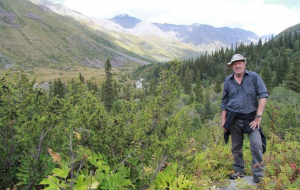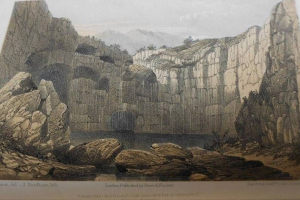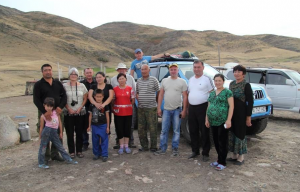GAITHERSBURG, MD – A British journalist is hoping to rekindle interest in two early European travellers to Kazakhstan, retracing some of their 19th century journeys in the country and hoping to draw more attention to their pioneering trips to Central Asia.
In 1848, Britons Thomas and Lucy Atkinson began a year-long journey across the territory of what is now Kazakhstan, becoming the first Europeans to visit some areas and in the process bearing a child who would bring the names of Kazakh mountains as far as U.S. legislatures. This summer, journalist and author Nick Fielding, with the support of the Kazakh Geographic Society, followed some of their paths, visiting sites still seldom seen by Westerners.
Fielding rediscovered the writings of Thomas Witlam Atkinson, a British artist and explorer, while researching the movements of peoples in Central Asia. “I realised that he had been forgotten in the modern world and it struck me as a good project to try and write a biography,” Fielding told The Astana Times in a Jan. 20 email. “The more I learned about him and Lucy, the more interesting it became. I decided that it would be interesting to try to plot their journey, using Thomas’s paintings and comparing them with modern-day photographs.”
The Atkinsons, according to Fielding, travelled in Central Asia and Siberia for seven years and covered more than 60,000 kilometres on horseback, reaching farther than any other explorers in some regions of the Urals, the Altai, Eastern Siberia, Eastern Tartary (now mostly eastern Russia), Djungaria (now northern China) and northern Mongolia.
The journey Fielding set out to recreate took the Atkinsons from Barnaul in the Altai region of Siberia through the Semey (formerly Semipalatinsk) region and south, according to his report, “Atkinson KazGeo Expedition to Eastern Kazakhstan.” From the newly built Cossack fort at Kapal, the Atkinsons made expeditions to the Alatau and Karatau Mountains, the Kora Valley, the Ak Su Valley, the springs at Arasan and other areas. (Thomas Atkinson’s books “Oriental and Western Siberia” and “Travels in the Region of the Upper and Lower Amoor” detail parts of these journeys.)
The Atkinsons travelled with armed guards and safe passage promises from the Kazakh sultans they had met on the way. Lucy, on this journey, was pregnant. Stuck in the rough fort at Kapal because of early, heavy snowfall – they had planned to leave in October – Lucy gave birth to their son, Alatau Tamchiboulac Atkinson, in November in the early days of a harsh winter that would kill more than 100 people in the settlement, including every other infant born around that time.
“Before she met Thomas, Lucy was the governess to a wealthy Russian family in St. Petersburg, the Muravyev-Vilenskys,” Fielding said, and had been living in Russia for seven years. This was not an unusual job for a young English woman in the 1840s, he said, and Lucy probably was able to speak English, French and Russian. “She was not a professional researcher, but her language skills would have been very useful to Thomas, who did not speak good Russian when he first arrived in 1846.”
When Lucy started out on her trip with Thomas in February 1848, Fielding said, she had little experience of horse-riding or living rough, but she learned to do both, as well as to shoot a pistol. “On one occasion she drew her pistols in order to prevent an attack on Thomas by bandits,” Fielding said. “She must have been a remarkably strong woman, as she kept riding until about a month before she gave birth to Alatau in Kapal in November 1848. I don’t think there are many other examples of British women travelling in such wild places at this time. She should be regarded as a great hero of travel!”
Fielding and his wife, Rosamund, began their retracing of the Atkinsons’ journey on Aug. 16, 2014, when they left Almaty in a four-by-four for the five-hour journey to the Djungar Alatau and the Kora Valley. They visited the remnants of the Cossack fort at Kapal, the southernmost point of the Russian Empire at the time the Atkinson’s arrived, Fielding said, and an important historical site that appears never to have been excavated. The couple travelled to the Tamchiboulac spring, from which young Alatau Atkinson received his name, which is still visited by locals for its supposed healing powers.
Fielding called the beauty of the Alatau Mountains and the Kora Valley striking. “I have travelled extensively and I can say that the Kora Valley is one of the most beautiful places I have ever seen,” he said.
He was also surprised to learn that the Atkinsons are still remembered in the Kapal area today. “There are people there who know about them and there are some stories still in the folk memories of people. I have been told that there are even some songs about Lucy, but I have not heard them,” he said. Kazakh hospitality also impressed the traveller: “I was treated extremely well everywhere and people did everything they could to help me. I will never forget this.”
Though the Atkinsons passed through Kazakhstan more than 160 years ago, Fielding thinks they would recognise much of the region today. “I don’t think the landscape has changed much in many of these regions and I think I have seen things that would be recognised by the Atkinsons. In Kazakhstan, I think there are fewer nomads – sadly, this way of life has declined. But in other places you can still find the same way of life. The beauty of the steppes is still there and the warmth and friendship of the people continues.”
Fielding said he hopes to return to Kazakhstan, to see other parts of the Atkinsons’ journey and, ideally, to make a film about the lives of Thomas and Lucy, who he calls important figures in Kazakhstan’s history.
The descendants of Thomas and Lucy also went on to be important figures in history: Alatau Tamchiboulac Atkinson, who spent the first six years of his life travelling with his parents, eventually returned to England, but at age 20 sailed to Hawaii. He became the editor of the Hawaiian Star newspaper, wrote a number of books and papers about the islands and, after the annexation of Hawaii by the United States, was charged with conducting the first U.S. Census of the islands. One of his sons, also Alatau T. Atkinson, went on to serve in Hawaii’s legislature. Alatau as a name lingered in Hawaii in subsequent generations of descendants.
In addition to Hawaii and England, members of the extended Atkinson clan ended up in New Zealand and Australia. Now, Fielding’s research and, perhaps, Kazakhstan’s greater prominence on the global scene appear to be driving a renewed desire by some Atkinson descendants to see the strange land their great-great-grandparents travelled. (A family culture of adventure also can’t be ruled out!).
Great-great-great-grandson of Thomas and Lucy, Henry Smith, who grew up in the U.K., said, “My immediate family are certainly adventurers at heart. My passion is for climbing and mountaineering expeditions and my brother is also fascinated with polar exploration. I’ve been on expeditions to Africa and the Alps, but it has always been a long-term goal of mine to visit the northern Tien Shan mountains on the Kazakh border. … Thomas and Lucy’s exploits have certainly been an inspiration, and finding out more recently has made the reality of an expedition to Kazakhstan more likely. Meeting the Kazakh ambassador [in London] at a talk recently has made me realise the importance of celebrating their journeys. If I can promote awareness of Thomas and Lucy, but also the relationship between the U.K. and Kazakhstan through a replica expedition of sorts, then I think that would be great.”
“I very much hope to return to Kazakhstan,” Fielding said, for his part. “There are parts of their journey, around Alakol and Zaisan [lakes], that I have not yet seen. Ideally, I would like to make a film about Thomas and Lucy’s lives, as they are very important figures in the 19th century history of Kazakhstan.”



